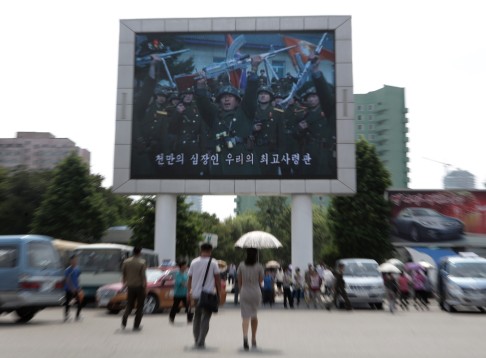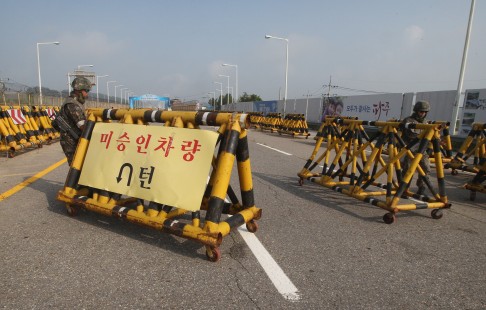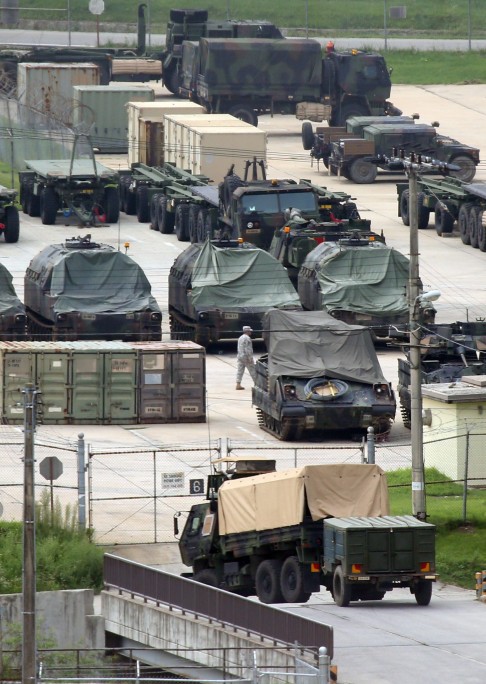South troops on maximum alert as 'war-ready' North Korea's deadline to end propaganda broadcasts draws near
PUBLISHED : Saturday, 22 August, 2015, 11:25am
UPDATED : Saturday, 22 August, 2015, 11:37am
Agence France-Presse in Seoul

South Korean President Park Geun-hye (left) appeared on television wearing army fatigues and saying that provocations from North Korean leader Kim Jong-un (right) would not be tolerated. Photos: AFP
South Korean troops stood at maximum alert today, with North Korea threatening to go to war unless Seoul meets a looming deadline to halt loudspeaker propaganda broadcasts across the border.
The North Korean People’s Army (KPA) said late last night that its frontline troops had moved into a “fully armed, wartime state” in line with the wishes of leader Kim Jong-un and ahead of the deadline at 5pm, local time, today.
Kim’s order yesterday to move to a war footing came after an exchange of artillery fire on Thursday that claimed no casualties but triggered a dangerous spike in cross-border tensions.
North Korean border troops had shelled loudspeakers on the South side, prompting South Korean soldiers to fire several artillery rounds back.

People in Pyongyang walk past a large screen broadcasting a propaganda movie showing soldiers chanting slogans while raising their weapons. Photo: AP
The clash came just days after Seoul resumed propaganda broadcasts that had halted for more than a decade – the practice was ended by mutual consent in 2004 – in response to land mine blasts that maimed two South Korean border soldiers earlier this month. Pyongyang denied a role in the land mine incident.
The latest incident outraged the North, which issued its 48-hour ultimatum.
South Korea says it has no intention of removing the loudspeakers, and on Friday President Park Geun-hye appeared on television, wearing army fatigues and telling top military commanders that further North Korean provocations “will not be tolerated”.
The North Korean foreign ministry warned in a statement early Saturday that “the situation which has reached the brink of war is now hardly controllable”.
The international community has long experience of North Korea’s particularly aggressive brand of diplomatic brinkmanship and, while there is concern over the potential for escalation, many see the situation as another exercise in sabre-rattling by Pyongyang.
“Given their past negotiating style and tactics, the likelihood that they will follow through with their threat of a military action is low,” said James Kim, a research fellow at the Asan Institute think tank in Seoul.

South Korean army soldiers today adjust barricades set up on Unification Bridge, which leads to the demilitarized zone, near the border village of Panmunjom in Paju, South Korea. Photo: AP
At the same time, Kim acknowledged that second-guessing Pyongyang’s game plan was always risky, and the possibility of a North Korean strike of some sort could not be ruled out.
“If so, South Korea must have a firm, strong, and timely response to signal its resolve that it will not be intimidated. Anything less would be an invitation for further provocation,” he said.
For the moment, there has been little sense of panic among ordinary South Koreans who have become largely inured over the years to the North’s regular – and regularly unrealised – threats of imminent war.
Officials say weekend traffic at South Korean highways is close to normal, and border town residents remain at home after returning from shelters during Thursday’s cross-border artillery fire.

Military trucks and other mobility equipment are readied at a US Army unit in Dongducheon, northeast of Seoul. Photo: EPA
North Korea also permitted more than 240 South Koreans to enter a jointly-run industrial complex at its border city of Kaesong today.
Technically, the two Koreas have been at war for the past 65 years, as the 1950-53 Korean conflict ended with a ceasefire that was never ratified by a formal peace treaty.
The last direct attack on the South was in November 2010 when North Korea shelled the South Korean border island of Yeonpyeong, killing two civilians and two soldiers.
The situation is being closely watched, with UN chief Ban Ki-moon calling for restraint from both sides and the United States urging Pyongyang to avoid further escalation.
There are nearly 30,000 US troops permanently stationed in South Korea, and the Pentagon has reiterated its commitment to the defence of its ally.
A call for calm and restraint also came from China, the North’s main diplomatic protector and economic supporter.
Ties between Beijing and Pyongyang have become strained, and China will be keen to avoid any regional flare-up as it seeks to attract world leaders to Beijing next month for a three-day celebration of Japan’s defeat in the second world war.
With additional reporting by Associated Press
